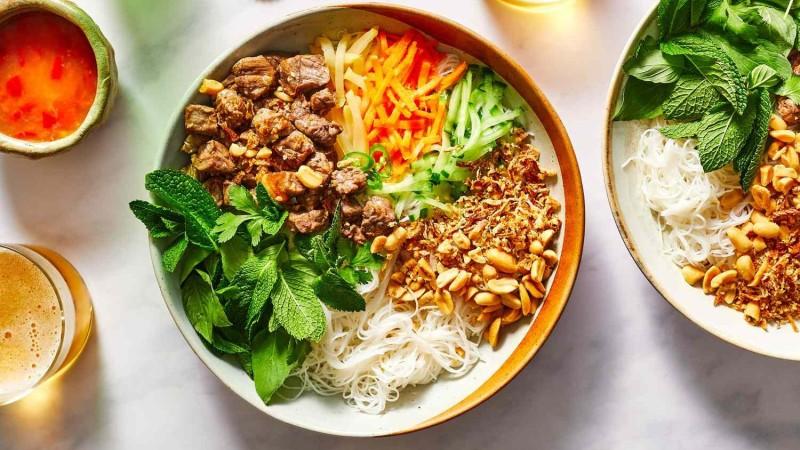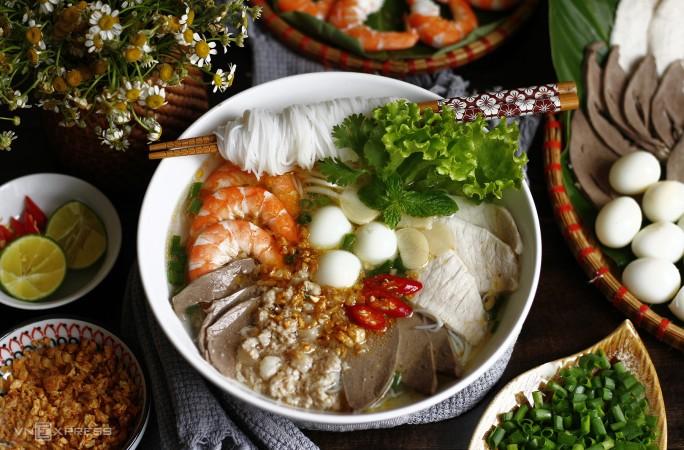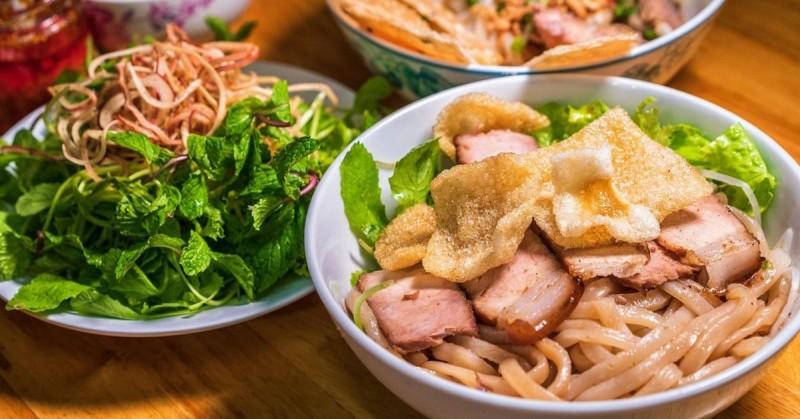Southern Vietnam's Cuisine: 10 Foods You Simply Must Try
Embark on a flavorful journey through Southern Vietnam, where the cuisine is as vibrant and diverse as the landscape itself. This region, known for its fertile lands and multicultural influences, offers a rich tapestry of dishes that tantalize the taste buds. Experience the creamy sweetness of fresh coconut milk in dishes like banh xeo, the tangy zest of bun thit nuong, and the lively street foods in bustling markets. Southern Vietnam's culinary scene is a feast for the senses, blending time-honored techniques with local ingredients to create unforgettable dining experiences.
Vietnam

1. Southern Pho
Pho, the quintessential Vietnamese noodle soup, has a fascinating history that begins in the north but truly blossoms in the south. The southern variation of pho is known for its slightly thicker noodles and a broth that's both sweet and bold. This version is served with an array of fresh herbs, mung bean sprouts, and a symphony of flavors from chili and hoisin sauces. Each spoonful reveals a dish that has traveled and evolved, capturing the essence of regional tastes and traditions.
In Southern Vietnam, pho is more than just a meal; it’s a beloved daily ritual. At dawn, bustling street corners fill with locals gathering for their morning bowl of pho. The broth, simmered for hours with bones and spices, unveils a complexity of flavors that provide both comfort and familiarity. Southern pho, with its added layers of sweetness and aromatic herbs, reflects the region’s abundance and culinary heritage, making it a staple in the local diet and a must-try for visitors.

Southern Pho - © Asian Inspirations
2. Banh Mi
No trip to Vietnam is complete without indulging in a banh mi. This humble sandwich, born from the fusion of French baguettes and Vietnamese ingenuity, is a staple of street food culture. With its crusty baguette filled with a medley of meats, pickled vegetables, and a tantalizing mix of sauces, the banh mi Saigon offers a taste of history and a glimpse into everyday life in Southern Vietnam and being ranked at the 6th most delicious street food in the world ranked my TasteAtlas - an international cuisine atlas.
The story of banh mi is one of adaptation and creativity. Introduced by the French during their colonial period, the baguette was transformed by the Vietnamese into something uniquely their own. Vendors skillfully assemble these sandwiches, layering pâté, cold cuts, and fresh herbs with a swift, practiced hand. Each ingredient, from the crunchy pickled carrots to the creamy mayonnaise, adds a burst of flavor and texture. Banh mi isn’t just a sandwich; it’s a symbol of Vietnam’s ability to take foreign influences and craft them into something extraordinary.

Banh Mi - © Delish
3. Bun Thit Nuong
Bun thit nuong is a delightful evolution of the northern dish bun cha, offering a unique culinary experience. This dish features tender grilled pork chops, marinated to perfection and served over thin rice vermicelli, all nestled on a bed of fresh vegetables. Finished with a flavorful fish sauce poured over, bun thit nuong achieves a harmonious balance that's both light and satisfying—ideal for the tropical heat.
The secret to bun thit nuong lies in its marinade—a fragrant blend of lemongrass, garlic, and fish sauce that infuses the pork with savory goodness. As the pork grills, it releases an irresistible aroma that draws people in from the street. The dish is a sensory delight, with the crunch of fresh vegetables, the chewiness of the vermicelli, and the tender, smoky pork creating a perfect harmony. Each bite offers a journey through the flavors of Southern Vietnam, making bun thit nuong an essential experience for any food lover.

Bun Thit Nuong - © The Spruce / Cara Cormack
4. Hu Tieu Nam Vang
Hu Tieu Nam Vang, a noodle dish reflecting Southern Vietnam's cultural melting pot, is a street food favorite. Chewy rice noodles swim in a rich broth made from pork bones, topped with various meats and seafood. Every bowl bursts with flavors and textures, from tender pork heart to fresh bean sprouts and chives. Whether enjoyed wet or dry, Hu Tieu Nam Vang showcases Southern Vietnam's culinary diversity.
The origins of Hu Tieu Nam Vang trace back to Cambodian and Chinese influences, illustrating the region's rich cultural tapestry. The broth, clear yet deeply flavorful, results from hours of simmering pork bones. Traditional Hu Tieu Nam Vang includes minced pork and succulent shrimp, each adding unique texture and taste. Savoring each spoonful, one can sense the bustling Saigon markets and vibrant street food culture, making this dish a must-try for culinary explorers.

Hu Tieu Nam Vang - © Vnexpress
5. Goi Cuon
Goi Cuon, or fresh spring rolls, encapsulate Vietnamese cuisine's freshness and vibrancy. Translucent rice paper wraps around crisp greens, succulent shrimp, and tender pork. Each bite is a refreshing burst of flavors, complemented by a tangy dipping sauce. Goi Cuon invites diners to experience the light, healthy, and aromatic delights defining Southern Vietnamese food.
The art of making goi cuon balances textures and flavors. Delicate rice paper wraps around a medley of ingredients without tearing. Inside, a mix of vermicelli noodles, fresh herbs, and savory proteins blend harmoniously. The dipping sauce, often a mix of fish sauce, garlic, chili, and lime juice, adds a zesty finish. Eating goi cuon is like enjoying a fresh, sunny day in Southern Vietnam, making it a must-try for any visitor.

Goi Cuon - © gather
6. Com Tam
Com Tam, once a humble meal for farmers, has transformed into a one of the most delicious street food in Vietnam. A plate of tender broken rice pairs with grilled pork, a fried egg, and savory fish sauce. The simplicity of Com Tam belies its rich flavors and satisfying textures, making it a must-try for anyone exploring Southern Vietnam's culinary landscape.
Originally, Com Tam utilized broken rice grains considered less desirable. Vietnamese ingenuity turned this into a beloved dish, rich in flavor and history. Street vendors serve Com Tam with the aroma of grilled pork drawing in patrons. The broken rice soaks up fish sauce, while the grilled pork adds a smoky, savory note. Each element, from the crispy fried egg to the pickled vegetables, blends harmoniously, reflecting Southern Vietnamese cuisine's resourcefulness and creativity.

Com Tam - © VnExpress/Bui Thuy
7. Cao Lau
Hailing from Hoi An, Cao Lau is steeped in tradition and mystery. Thick noodles, similar to Japanese udon but uniquely Vietnamese, are topped with slices of barbecued pork, fresh herbs, and crunchy pork cracklings. Legend has it that authentic Cao Lau is cooked with water from Hoi An's ancient Ba Le well, adding a touch of magic to this enchanting dish.
Cao Lau connects to Hoi An's rich trading history, reflecting Chinese, Japanese, and Vietnamese culinary traditions. The noodles, firmer and chewier than typical Vietnamese noodles, combined with savory barbecued pork and fresh herbs, create a unique texture and flavor. Crispy pork cracklings add an extra layer of texture, making each bite delightful. Cao Lau offers a taste of Hoi An's storied past and vibrant present.

Cao Lau - © Saigoneer
8. Banh Xeo
Banh Xeo, a crispy pancake from the Mekong Delta, is a sensory delight. The batter sizzles and crackles on a hot pan, filling the air with a mouth-watering aroma. Made from rice flour and coconut milk, the pancake is stuffed with pork, shrimp, and bean sprouts, then folded into a golden crescent. Banh Xeo is more than just food; it's a lively performance that leaves a lasting impression.
Banh Xeo, meaning "sizzling cake," lives up to its name with its delightful preparation process. A skilled vendor swirls the batter in the pan, creating a thin, crispy shell. The filling's aroma draws passersby, blending the crispy pancake with savory filling. Wrapped in fresh lettuce leaves and dipped in tangy fish sauce, Banh Xeo offers a symphony of flavors and textures, capturing Southern Vietnam's dynamic street food culture.

Banh Xeo - © VnExpress
9. Bun Bo Hue
Bun Bo Hue, from Hue city, offers a bold and spicy taste adventure. A bowl filled with tender beef slices, pork hock, and spicy sausage bathes in a rich, flavorful broth. Shrimp paste adds unique depth, while fresh herbs and vegetables bring vibrant freshness. Bun Bo Hue exemplifies Southern Vietnam's complex and diverse flavors.
Celebrating Hue's royal culinary heritage, the broth, simmered with beef bones and lemongrass, creates a rich, aromatic base. Shrimp paste adds unique umami flavor, setting Bun Bo Hue apart from other noodle soups. Enjoying this hearty dish on a cool evening, with the broth's warmth and chili paste's spiciness, creates a comforting experience. Bun Bo Hue is a must-try for exploring bold and complex Southern Vietnamese flavors.

Bun Bo Hue - © h2tfood.vn
10. My Quang
My Quang, or Quang-style noodles, stands out for its vibrant presentation and rich flavors. Yellow rice noodles, topped with proteins like shrimp, pork, and even frog, are adorned with fresh herbs, crushed peanuts, and a simmering broth. My Quang celebrates Southern Vietnam's culinary creativity, turning simple ingredients into a masterpiece.
The turmeric-infused rice flour noodles give My Quang its distinctive color and flavor. The intensely flavorful broth, simmered with shrimp, pork, and aromatic spices, complements the noodles. Each bowl, topped with fresh herbs, banana blossoms, and crunchy peanuts, creates a feast for the eyes and palate. My Quang, served with crispy sesame rice crackers, exemplifies Southern Vietnamese cuisine's ingenuity and creativity.

My Quang - © gather
Conclusion
Vietnamese cuisine is a vibrant tapestry of flavors and textures, far beyond pho and banh mi. It's a culinary journey reflecting the country's rich cultural heritage and regional diversity. If you're eager to explore Vietnam's gastronomic delights, embark on a culinary adventure with Tweet Tours, where you can savor the best of Vietnamese cuisine.
Articles for you

Experience Aboard The RV Indochine II - A Mekong Cruise With Tweet World Travel
The RV Indochine II is a luxury river cruise ship, offering an unforgettable journey through many attractions along the Mekong River. Built in 2017, this upscale vessel combines colonial elegance with modern conveniences to create a comfortable yet stylish environment for its crew and passengers. The ship’s intimate size makes it ideal for those seeking a more personal cruising experience while exploring Vietnam and Cambodia rich culture, scenery, and heritage. Whether you're gazing at the landscape from your private balcony or enjoying authentic local cuisine, RV Indochine II promises an exotic adventure like no other.

Witness Stilt Fishing In Sri Lanka: An Eco-Tourism Experience
Sri Lanka, renowned for its stunning beaches and rich cultural heritage, harbors a unique tradition that has captivated travelers for centuries: stilt fishing. This ancient practice, passed down through generations of coastal communities, blends artistry with necessity, offering a glimpse into a way of life intimately connected to the island's coastal rhythms. Stilt fishing in Sri Lanka isn't merely a means to catch fish; it's a cultural emblem, embodying the resilience and ingenuity of Sri Lanka's fishing communities.

Make Your Trip Stress-Free With The Tweet Trip App
Embark on your next adventure with confidence by downloading the Tweet Trip App, available for both iOS and Android. This essential travel companion allows you to view your detailed itinerary, stay connected with your tour guide and fellow travelers, receive real-time updates, and provide feedback effortlessly. With features like in-app messaging, emergency assistance, and location sharing, the Tweet Trip App ensures you travel smarter, stay connected, and enjoy a seamless, worry-free journey. Get started today and make the most of your travel experience with Tweet World Travel.

Pedal Through Paradise: Unveiling Cambodia's Hidden Gems on Two Wheels
The gentle whir of bicycle wheels mingles with the distant chants of monks as you glide past emerald rice paddies stretching to the horizon. This is Cambodia - a sensory explosion waiting to be experienced on two wheels. At Tweet Tours, we believe there's no better way to immerse yourself in the Kingdom of Wonder than by bicycle.
Cambodia isn't just a destination; it's a living, breathing tapestry of ancient wonders, natural beauty, and vibrant culture. Our carefully crafted cycling tours take you beyond the typical tourist haunts, offering a unique perspective on this captivating country. Ready to clip in and discover the magic of Cambodia? Let's ride!

Trekking in the Himalayas: A Journey Through Nepal's Majestic Peaks
The Himalayas rise from the earth like colossal guardians, their snow-capped peaks piercing the sky in a display of nature's raw power and beauty. Nepal, nestled at the heart of this mountain range, serves as the gateway to some of the most breathtaking trekking experiences on the planet. Here, the air is crisp and thin, filled with the promise of adventure and the whispers of ancient tales.
With Tweet Tours, as you set foot on these hallowed trails, you're not just a traveler - you're a modern-day explorer, following in the footsteps of legendary mountaineers and age-old traders. Each step takes you further into a world where nature reigns supreme and human resilience is tested against the backdrop of some of the world's highest peaks.
From the moment your boots touch the ground in Kathmandu, you'll feel the pull of the mountains. The bustling streets of the capital, with their sensory overload of sights, sounds, and smells, soon give way to serene mountain paths where the only soundtrack is the crunch of gravel underfoot and the distant tinkling of yak bells.

Exploring Mui Ne's Wonders: Unique Attractions & Local Dishes
Nestled along the southeastern coast of Vietnam, Mui Ne emerges as a captivating gem, blending natural wonders with cultural richness. Renowned for its stunning landscapes and unique attractions, Mui Ne beckons travelers seeking both relaxation and adventure in equal measure. Mui Ne's renowned beach dunes, bustling fishing towns, and excellent local food await exploration at every turn.
The allure of Mui Ne lies not only in its pristine beaches and crystal-clear waters but also in its diverse range of activities catering to every traveler's whims. Whether you're drawn to thrilling water sports like kitesurfing and windsurfing on its dynamic shores or seeking tranquility amidst the picturesque Fairy Stream, Mui Ne promises an unforgettable journey filled with discovery.
